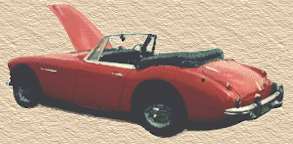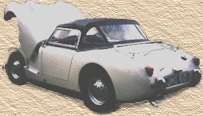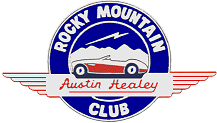|
RMHC
Annual Checklist
WHILE THE CAR IS ON THE GROUND:
1. Check cooling system: radiator
cap should be replaced to prevent excessive pressure build up which will cause
the radiator top tank to bulge. Hoses and belt should be checked for cracks.
Always carry a spare lower radiator hose in your boot, and don't forget to check
the strength of your antifreeze. Make sure the belt tension is correct or else
you'll cause premature death to your water pump and generator bearings.
2. Top up steering and idler
boxes.
3. Check fluid in carb dash pots
( engine oil will do ), lubricate carb linkages and cables.
4. Check brake fluid reservoir.
Fluid should reach the top of the inner can. If it is low, look for leaks and
make necessary repairs. Outer portion feeds the brake system, inner portion
feeds the clutch.
5. Check all your ignition wires.
6. Check the front shock bolts to
make sure they are tight. They hold your front end together so make sure these
are snug!
7. Make sure your battery is
securely fastened. Clean the posts.
IF ALL IS WELL, GO FOR A TEST
DRIVE, LISTEN FOR CLUNKS AND SQUEAKS. ONCE THE CAR IS WARMED UP, YOU ARE READY
FOR THE OIL CHANGE AND THE REST OF THE SAFETY CHECK.
1. Jack the car up properly. Do
not use hollow front and rear member as jacking points! Make sure you have
strong jack stands-don't use the cheap, flimsy ones unless your life insurance
is paid up and we are your beneficiaries.
2. Check your rubber bushings of
the sway bar, check for cracks where the A-arm attaches to the chassis and also
check for cracks where the engine mounts attach to the chassis.
3. Look for signs of rust, there
are lots of good chemicals out there to slow down rust. Untreated, rust can
accelerate quickly and you're then looking at a substantial structural repair
bill.
4. Clean out the area behind the
door and in the rear fender wheel well.
5. Lubricate everywhere there is
a grease fitting.
6. Check and change if necessary,
not only your transmission/ overdrive oil, and the differential oil.
7. Check your brake hoses. If
they are 30-40 years old, you should consider replacing the rubber hoses.
Always a good idea to stamp down on your brakes and look for leaks. The
steel lines can rust.
8. Check the rubber bushings that
are holding the transmission in place. They'll help to keep your transmission
and engine from rocking forward.
9. Check your hubs and wheels and
grease them. Remember worn out splines on either the hub or the wheel can cause
you to lose a wheel while driving. To check front wheels: have someone apply the
brakes, then rock the wheels from side to side; for the rear, apply the hand
brake and rock the wheel. There should be no slop when you rock the wheels.
10. Don't forget to check the
brake pads - if worn, replace them.
11. Spin the front wheels and
listen for bearing noise. Replace noisy bearings. Grab the bottom of the front
wheel move it in and out, if there is any movement, it can indicate wear on the
king pin/ wheel bearing. Pump grease into the bottom king pin grease fitting, if
the movement persists, it means a wheel bearing problem - either worn out or not
shimmed properly.
12. You can also take this
opportunity to adjust your steering, although this takes a BSF wrench which can
be difficult to find.
 Supplied
by:- Healey Surgeons Inc.,
Supplied
by:- Healey Surgeons Inc.,
7211, Carroll Avenue,
Takoma Park,
MD 20912
U.S.A.
Phone:301 270 8811
Fax:301 270 8812
'28 years experience in healeying'
1. Anodised Aluminium Trim
If the anodising is now a little
dull and you prefer the shinier finish of polishing an easy way to remove the
old anodising is to use a proprietary oven cleaner. Spray , leave for 15 minutes
or so and wash clean. It is safer to remove the part from the car first as the
cleaner will ruin paintwork and trim.
2. Stripping for Restoration
If at all possible when
rebuilding work on one side at a time. This way you will have an untouched side
to see how the panels fit and take appropriate measurements.When stripping a car
for restoration be as methodical as you can making as many notes as possible as
to how things locate and take lots of measurements. It is tempting to think that
you will remember how the parts go back together when you are disassembling
them…believe me after several weeks or months You Won't!
3. Fitting Wings
This is probably the most
difficult task when rebuilding the outer body and to achieve a good result MUST
be tackled in the correct manner. Always start at the door and line up the panel
so that the swage line matches and the door gap is correct. When this is secured
proceed to fit the wing along the top edge to the shroud. On reaching the front
or back (as the case may be) it should be possible to pull/push the shroud to
meet the wing. If the depth of the wing or the curvature do not seem correct,
place a jack under the lower edge and gently force the panel into shape.
4. Fitting Seat Covers
To ease the fitting of seat
covers , first wrap the seat foams tightly in thin polythene and the covers will
then slide easily over the foams making adjustment considerably easier.
5. Restoration*
When carrying out a full
restoration we would recommend fitting the engine and gearbox into position
before fitting the outer bodywork. These units weigh several hundred pounds and
as a result the chassis bends slightly. The chassis flexing is enough to ruin
perfectly set up door gaps and in some cases the door gap to rear wing closes
completely.
 *
Supplied by:- J.M.E. Healey.
*
Supplied by:- J.M.E. Healey.
4a. Wise Terrace,
Leamington Spa,
Warwickshire,
CV31 3AS.
England.
Phone:01926 425038
1. Worn Splines
If the splines on your hubs and
wheels are very badly worn a temporary cure is to wrap a thin piece of tin foil
around the hub splines before forcing the wheel back on.
2. Hub Nuts*
Always tighten rear hub nuts with
a torque wrench to 600lbs in ( 6.91 kg m ).
The fitting of new hub nuts with
Loctite is recommended every time the hubs are removed, and check regulary for
tightness.
3. Brakes*
1. Change brake fluid every 2
years.
2. Replace flexible brake hoses
every 3 years.
*
Supplied by:- J.M.E. Healey.
1. Fan Belt
Always ensure that the fan belt
is adjusted to the correct tension as given in the Workshop Manual (1"
lateral movement for both big Healeys & Sprites) because overtightening can
result in the premature failure of both the Water Pump bearings and also those
in the Dynamo.
1. Blinking Bulbs
Take care to really clean those
lamp contacts and smear the inside of the holders with petroleum jelly. This
should ensure a good electrical contact and keep out the wet.
1. Access to Engine
To improve access to the engine
compartment by opening the bonnet wider, tie some strong cord to the bonnet and
secure it tightly to the boot lid handle. WARNING
make sure that you lock the boot to prevent any comic opening the boot while
your head is under the bonnet!!!!!
2. Cylinder Head Removal
To loosen a cylinder head prior
to removal , first remove all the head nuts (remembering to loosen in the
correct order) and then with the spark plugs still in place but NOT
connected , operate the starter briefly a couple of times. The head should now
be easy to remove.
3. Seized Clutch
Freeing a seized clutch is a
problem with which most of us are faced at some time or another. Prevention is
better than cure so when you tuck up your car for the winter remember to insert
a suitable piece of wood (cushioned at end) between the depressed clutch pedal
and the steering wheel Assuming that you have not had the foresight to do this
and the clutch is firmly seized you have several options depending on the
firmness with which it is stuck. It is always a good idea to start the car and
let the engine reach operating temperature , the heat will then spread back to
the clutch , hopefully making your job easier. Switch off the engine and select
first gear or reverse. Make absolutely sure that there are no
obstructions either in front or behind and operate the starter in short , sharp
bursts. Alternatively, you can jack the back up so that the rear wheels are off
the ground. With the brakes off and the clutch depressed start the engine and
run at approximately 1500 rpm in a high gear. Then apply the brakes GENTLY and
NOT for a sustained period. This should free all but the most reluctant clutch.
The last resort, and one that should not be undertaken lightly for fear of
causing expensive damage to other components is to follow the above instructions
but instead of applying the brakes get a helper to lower the jack by opening the
hydraulic valve. Be prepared to stop the car immediately and give yourself
plenty of space!!
4. Oil Problems
One of the engine problems with
the 6 cyl. is that it is prone to pump too much oil into the rocker cover. It
was therefore common practice to blank off the top oil hole on alternate rocker
arms to reduce the flow. Don't be concerned there is still plenty of lubrication
for the rocker gear.
5. Overdrive Solenoid *
CAUTION:
incorrect adjustment can cause major transmission and overdrive damage by having
the solenoid come on when it shouldn't be. Also, you'll risk cooking the
solenoid.
All solenoids' should be tested
before fitting into the car. A good solenoid will almost jump in your hand when
energised. Cleaning points or checking alignment of points often will get a
solenoid going again. While the cap is off, check to see if the points to the
primary winding open up when the plunger is at the top of the stroke.
How to set the adjustment
On late model overdrive units
there is an adjustment to the limit the overall travel of pinch bolt lever
operated by the solenoid plunger. On earlier models, you can install a 10/32
machine screw in the hole below the solenoid. Use a nut both above and below the
hole to keep the screw in place.
The adjustment setting seems
to work best at 3/16" to 7/32".
You would want half of the travel
to be free and the other half of travel to lift the spring loaded ball. You
should be able to feel the resistance in the transition between free play and
when the ball starts to lift ( at the half way point ).
Check to see if at the "on
" position, the adjust lever can still be lifted slightly, this will ensure
the primary points are opened and the secondary winding is holding the plunger.
You can double check yoour adjustment by using the factory manual method and it
should be very close.
The method outlined above takes
into account wear on the components and address the overall lift of the plunger.
 *
Supplied by:- Healey Surgeons Inc.,
*
Supplied by:- Healey Surgeons Inc.,
7211, Carroll Avenue,
Takoma Park,
MD 20912
U.S.A.
Phone:301 270 8811
Fax:301 270 8812
'28 years experience in healeying'
1. Unleaded Fuel *
As the phasing out of 4-star fuel
approaches all Austin Healey engines can be modified to run on unleaded fuel by
fitting hardened valve seats and new valve guides or, alternatively, a new
aluminium head can be fitted.
 *
Supplied by:- J.M.E. Healey.
*
Supplied by:- J.M.E. Healey.
4a. Wise Terrace,
Leamington Spa,
Warwickshire,
CV31 3AS.
England.
Phone:01926 425038
WINTER STORAGE: *
1. Steam clean under body and
recoat with a superior modern cavity wax material.
2. Store your Austin Healey on
blocks to unload suspension.
3. Deflate tyres.
4. Check antifreeze.
5. Disconnect battery and trickle
charge regularly.
6. Petrol deteriorates -
preferably drain the tank, or alternatively top up the tank when the car is
required.
7. Store the car with the
handbrake off.
8. Start the engine and warm up
regularly if possible.
9. Spray engine bay with DW40, or
similar to prevent corrosion occurring on plated fittings.
10. Cover car with a soft
absorbent cover.
*
Supplied by:- J.M.E. Healey.
1. Car Ramps
A useful tip to prevent the ramps
slipping away from the car when attempting to drive the car up them is to cut a
strip of old carpet slightly narrower than the ramps and approximately 5 feet
long. Fold the carpet around the bottom rung on the ramps and pull back
approximately half the length. This will secure the position of the ramps as the
car is driven at them.
2. Economy Rust Remover
Soak the parts for several days
in vinegar and then give them a good wire brushing.
3. Using your Jack
Insert a fairly substantial and
as long as practicable, piece of wood between the jack and the chassis section.
This will prevent any damage to the frame.
4. Routing cables through the dashboard
An easy way of ensuring that
replacement cables are routed in the correct manner is to disconnect the cable
on the engine side and join a strong piece of cord to the end. Pull out the
cable from the dashboard side pulling the cord with it. The replacement cable
can then be attached and pulled into the engine compartment by the cord. Don't
forget to ensure that the securing nut is the correct side of the dashboard
before pulling through the cable.
5. Lubrication*
Lubricate rear springs with 50/50
paraffin and oil.
100/4 Owners - regularly
lubricate the pedal cross shaft, which is often overlooked. If it seizes up the
brakes will come on when you press the clutch pedal!
*
Supplied by:- J.M.E. Healey.
1. Rear Shock Absorber Links
When replacing these on all cars
up to the late Mk 3 3000 ensure that they are fitted above the shock absorber
arm and not below as is customary. It is quite possible to assembly them
incorrectly but the effect is that the shock absorber arm is almost at the end
of its travel in the static position, so that even a small amount of movement
will result in breakage.
2. Front Wheel Bearing*
Start by putting the new races
for the liner and outer bearings in the freezer to make it easier to install.
Install the races.
Put 90 weight oil on your inner
bearing and offer it up to the spindle. The oil will provide protection from
damage due to bearing running dry but at the same time, not give you a false
reading when trying to shim the bearings.
Next goes the bearing spacer,
then the shims, starting with the thickest one .030, then .010, .050, .030, (
one of each ). Offer up the front hub, without the seal. Again, bathe the outer
bearing in oil. Line up the tab of the washer with the groove in the spindle and
tighten the castle nut, so everything lines up.
If it drags when you tighten the
castle nut, then you need to add shims. If it is to loose, you need to remove
the shims, When it is correct, re-tighten to the correct specs. At this point,
the hub should be turning freely, with no end float and no pre-load.
Once you are satisfied that you
have the bearings set up correctly, the remove everything. Make sure you keep
track of the shims! Now pack the wheel bearings with wheel bearing grease and
install your front seal and reassemble unit.
 *
Supplied by:- Healey Surgeons Inc.,
*
Supplied by:- Healey Surgeons Inc.,
HOME | MEMBERSHIP
| CONTACT US | EVENTS
| TECHNICAL | LINKS
| FUN STUFF | PICTURES
|

 Supplied
by:- Healey Surgeons Inc.,
Supplied
by:- Healey Surgeons Inc., *
Supplied by:- J.M.E. Healey.
*
Supplied by:- J.M.E. Healey.
 *
Supplied by:- Healey Surgeons Inc.,
*
Supplied by:- Healey Surgeons Inc., *
Supplied by:- J.M.E. Healey.
*
Supplied by:- J.M.E. Healey.